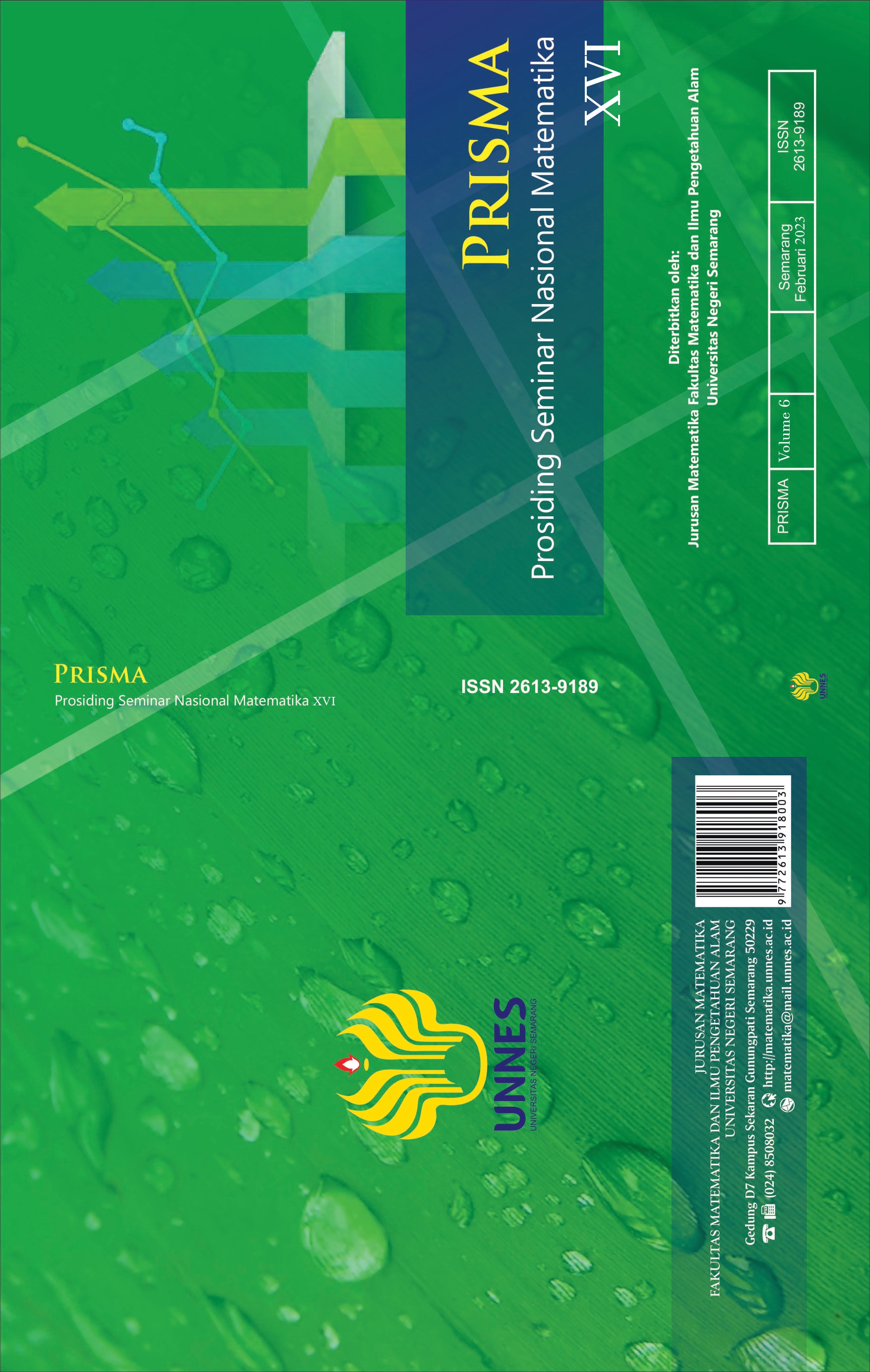Study of ICT Integrated Challenge Based Learning on Statictical Thinking Ability
Main Article Content
Abstract
The research method used is a literature study that uses secondary data with search keywords according to the purpose. The data analysis technique consists of three stages, namely organize, synthesize, and identify. The results achieved are the formation of stages of learning ICT integrated challenge based learning model based on the literature that has been analyzed and the relationship between ICT integrated challenge based learning models on statistical thinking ability. Based on the results and discussion, it was obtained that the ICT integrated challenge based learning model can be an innovative solution to develop statistical thinking ability. Learning with an ICT integrated challenge based learning model will facilitate students to carry out activities in a series of processes that are mutually sustainable, ranging from identification, characterization, measurement, control and reducing variation activities providing opportunities for improvement in the process to be able to solve problems related to data in real word problem as it becomes characteristic of statistical thinking. The suggestion proposed is that further research is needed on the development of learning instruments and media with an ICT integrated challenge based learning model that contains indicators of statistical thinking ability and the implementation of these models in mathematics learning.
Article Details
References
Education, A. (2010). Challenge based learning: A classroom guide. Cupertino, California: Apple, Inc. http://cbl. digitalpromise. org/wp-content/uploads/sites/7/2016/08/CBL_Classroom_Guide2010. pdf.
Hidayat, A., & Perdana, F. J. (2021). Media Hippo Animator pada Pembelajaran Statistika dalam Upaya Meningkatkan Kemampuan Statistik dan Self-confidence Mahasiswa di Era Pandemi Covid 19. JUMLAHKU: Jurnal Matematika Ilmiah STKIP Muhammadiyah Kuningan, 7(2), 100-126.
Hidayati, T., Handayani, I., & Ikasari, I. H. (2018). Penggunaan ICT dalam Penyusunan Modul Statistika. Jurnal Informatika Universitas Pamulang, 3(3), 151-172.
Johnson, L.F., Smith, R.S., Smythe, J.T. and Varon, R.K., 2009. Challenge-based learning: An approach for our time (pp. 1-38). The new Media consortium
Keputusan Kepala Badan Standar, Kurikulum dan Asesmen Kementerian Pendidikan, Kebudayaan, Riset, dan Teknologi nomor 088/H/KR/2022 tentang capaian pembelajaran pada kurikulum merdeka
La Nani, K. 2015. Kemampuan Penalaran Statistis, Komunikasi Statistis, dan Academic
Help-Seeking Mahasiswa melalui Pembelajaran Berbasis Proyek Berbantuan
ICT. Disertasi UPI
La Nani, K., & Alhaddad, I. (2020). Efektivitas Pembelajaran Berbasis Proyek Berbantuan ICT dalam Peningkatan Kemampuan Komunikasi Statistis Siswa SMP Negeri 2 Kota Ternate pada Materi Statistika. Delta-Pi: Jurnal Matematika dan Pendidikan Matematika, 9(2).
Lubis, Z. (2021). Statistika terapan untuk ilmu-ilmu sosial dan ekonomi. Penerbit Andi.
Lukman, H. S., & Setiani, A. (2018). Validitas Bahan Ajar Statistika Terapan Berbasis ICT Terintegrasi Proyek. Edumatika: Jurnal Riset Pendidikan Matematika, 1(2), 36-46.
Lukman, H. S., & Sutisnawati, A. (2016). Pengembangan Bahan Ajar Statistika Berbasis Information and Communication Technology (ICT).
Moore, D. S. (1998). Statistics among the liberal arts. Journal of the American Statistical Association, 93(444), 1253-1259.
Nichols, M., Cator, K., & Torres, M. (2016). Challenge based learning guide. Nichols, M. and Cator, K. and Torres, M., Redwood City, CA, USA.
Peraturan Pemerintah Republik Indonesia Nomor 19 Tahun 2017 Tentang Perubahan Atas Peraturan Pemerintah Nomor 74 Tahun 2008 Tentang Guru
Perienen, A. (2020). Frameworks for ICT integration in mathematics education-A teacher’s perspective. Eurasia Journal of Mathematics, Science and Technology Education, 16(6), em1845.
Piotrowski, M. (2010). What is an e-learning platform?. In Learning management system technologies and software solutions for online teaching: Tools and applications (pp. 20-36). IGI Global.
Ramadhani, R., & Narpila, S. D. (2018, April). Problem-Based Learning Dengan Karakteristik Budaya Lokal Sebagai Salah Satu Alternatif Untuk Meningkatkan Kemampuan Berpikir Statistik Siswa. In Prosiding Seminar Nasional STKIP PGRI Sumatera Barat, Padang, Sumatera Barat: STKIP PGRI Sumatera Barat (pp. 142-50).
Robert C. delMas (2002) Statistical Literacy, Reasoning, and Thinking: A Commentary, Journal of Statistics Education, 10:2, , DOI: 10.1080/10691898.2002.11910674
Shaughnessy, J.M. 1997. Missed Opportunities in Research on The Teaching and Learning of Data and Chance. Sydney: MERGA
Siswono, T. Y. E., Hartono, S., & Kohar, A. W. (2018). Effectiveness of project based learning in statistics for lower secondary schools. Eurasian Journal of Educational Research, 18(75), 197-212.
Snee, Ronald. 1990. Statistical Thinking and Its Contribution to Total Quality. The American Statistician Journal. Edition May 1, page 116-121.
Suryani Lukman, H., & Setiani, A. (2018). PENGEMBANGAN BAHAN AJAR STATISTIKA TERAPAN BERBASIS INFORMATION AND COMMUNICATION TECHNOLOGY (ICT) TERINTEGRASI PROYEK.
Susilawati, W., Abdullah, R., & Rosyidah, I. (2019). Peningkatan kemampuan berpikir statistis mahasiswa melalui challenge-based learning dengan strategi konflik kognitif. Jurnal analisa, 5(1), 31-40.
Szabo, M. (2002). Cmi theory and practice: Historical roots of learning managment systems. In E-Learn: World Conference on E-Learning in Corporate, Government, Healthcare, and Higher Education (pp. 929-936). Association for the Advancement of Computing in Education (AACE).
Waru, M. V., & Minggi, I. (2015). Deskripsi persepsi tentang statistika ditinjau dari tingkat statistical thinking ability (statistical thinking) pada mahasiswa jurusan pendidikan IPS Terpadu Fakultas Ilmu Sosial Universitas Negeri Makassar. Daya Matematis: Jurnal Inovasi Pendidikan Matematika, 3(1), 70-77.
Widakdo, W. A. (2017). Mathematical representation ability by using project based learning on the topic of statistics. In Journal of Physics: Conference Series (Vol. 895, No. 1, p. 012055). IOP Publishing.
Wididi, Agus. (2016). Pengaruh Penggunaan Model Problem Based Learning Terhadap Kemampuan Berpikir Statistik Siswa Kelas X SMK Sultan Agung Sumber.
Yoisangaji, S., La Nani, K., & Abdullah, I. H. (2019). Peningkatan Kemampuan Komunikasi Statistis Siswa pada Pokok Bahasan Ukuran Letak Data melalui Pembelajaran Berbasis Proyek Berbantuan Informasi Komunikasi dan Teknologi (ICT). Delta-Pi: Jurnal Matematika dan Pendidikan Matematika, 8(1).
